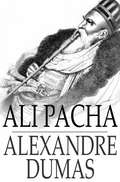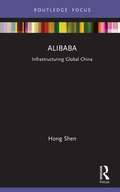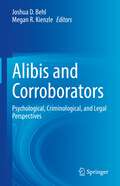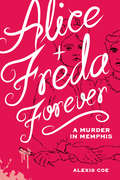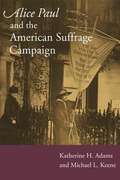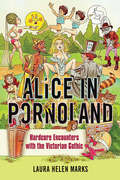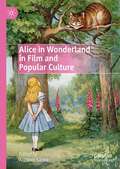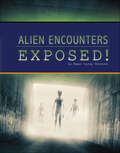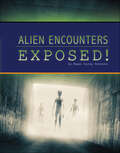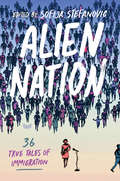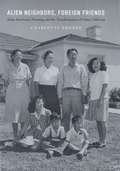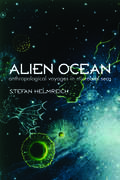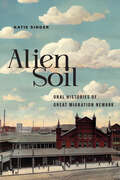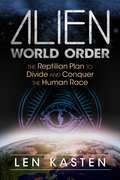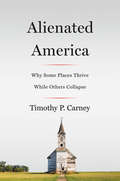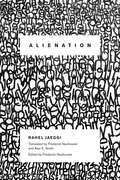- Table View
- List View
Ali Pacha / Celebrated Crimes
by Alexandre DumasCan't get enough true crime? Love to hate history's miscreants? Dive into a juicy slice of early modern history with this gripping account of the life of Ali Pacha, a remorseless tyrant who ruled over part of the Ottoman Empire with an iron fist. <P> <P> This account of Pacha's many transgressions will enthrall and appall even longtime fans of the true crime genre.
Alibaba: Infrastructuring Global China (Global Media Giants)
by Hong ShenThis book examines the political-economic dynamics in the development of a leading global Internet giant: Alibaba. As both a prominent example of, as well as providing the basic infrastructure for, China’s outward expansion, Alibaba demonstrates the complex interplay between different state agencies and units of capital in the context of the rise of global China. Hong Shen investigates the development and expansions of Alibaba and discusses how Alibaba has not only become a leader of China’s increasingly globalizing internet but has also increasingly served as a basic infrastructure model for other Chinese companies to go global. Shen also addresses how this process has been constantly shaped and reshaped by complex state-capital interactions along the way. This book shows how different units of capital, both inside and outside of China, have interacted with Alibaba’s developmental strategies and illustrates how different state agencies, both domestic and international, have enabled or constrained the company’s development, especially its global expansion. This book will appeal to students and scholars of critical political economy of media, global media and digital industries, communication, technology and society, and internet studies. It will also be relevant to policy-makers working in the arena of global internet and trade policies.
Alibis and Corroborators: Psychological, Criminological, and Legal Perspectives
by Joshua D. Behl Megan R. KienzleThis book aims to increase understanding of alibis and corroborators, examining the role alibis play – or fail to play – in innocence cases. It analyses the factors that can influence the suspect, the defense team, the alibi corroborator, and ultimately the alibi statement itself. Recognition of and reactions to wrongful convictions have been on the rise as researchers and society take a closer, more critical look at America’s criminal justice system. In addition to serving as a complete review of the science, this volume discusses issues such as alibi generation; alibi believability; a proposed theory of alibis; international comparisons of issues in alibi corroboration; age and gender differences in alibi corroboration; attorney perceptions and use of alibi evidence; and erroneous alibis. Offering an in-depth, empirical view, this book will appeal to students and researchers interested in Criminology, Legal Psychology, Social Psychology, Law, and practitioners in our legal and criminal justice systems who are making tough decisions about this distinctive witness type.
Alice + Freda Forever
by Alexis CoeIn 1892, America was obsessed with a teenage murderess, but it wasn't her crime that shocked the nation--it was her motivation. Nineteen-year-old Alice Mitchell had planned to pass as a man in order to marry her seventeen-year-old fiancée Freda Ward, but when their love letters were discovered, they were forbidden from ever speaking again. Freda adjusted to this fate with an ease that stunned a heartbroken Alice. Her desperation grew with each unanswered letter--and her father's razor soon went missing. On January 25, Alice publicly slashed her ex-fiancée's throat. Her same-sex love was deemed insane by her father that very night, and medical experts agreed: This was a dangerous and incurable perversion. As the courtroom was expanded to accommodate national interest, Alice spent months in jail--including the night that three of her fellow prisoners were lynched (an event which captured the attention of journalist and civil rights activist Ida B. Wells). After a jury of "the finest men in Memphis" declared Alice insane, she was remanded to an asylum, where she died under mysterious circumstances just a few years later. Alice + Freda Forever recounts this tragic, real-life love story with over 100 illustrated love letters, maps, artifacts, historical documents, newspaper articles, courtroom proceedings, and intimate, domestic scenes--painting a vivid picture of a sadly familiar world.
Alice Paul and the American Suffrage Campaign
by Katherine H Adams Michael L KeenePast biographies, histories, and government documents have ignored Alice Paul's contribution to the women's suffrage movement, but this groundbreaking study scrupulously fills the gap in the historical record. Masterfully framed by an analysis of Paul's nonviolent and visual rhetorical strategies, Alice Paul and the American Suffrage Campaign narrates the remarkable story of the first person to picket the White House, the first to attempt a national political boycott, the first to burn the president in effigy, and the first to lead a successful campaign of nonviolence. Katherine H. Adams and Michael L. Keene also chronicle other dramatic techniques that Paul deftly used to gain publicity for the suffrage movement. Stunningly woven into the narrative are accounts of many instances in which women were in physical danger. Rather than avoid discussion of Paul's imprisonment, hunger strikes, and forced feeding, the authors divulge the strategies she employed in her campaign. Paul's controversial approach, the authors assert, was essential in changing American attitudes toward suffrage.
Alice in Pornoland: Hardcore Encounters with the Victorian Gothic (Feminist Media Studies #21)
by Laura Helen MarksThe unquenchable thirst of Dracula. The animal lust of Mr. Hyde. The acquiescence of Lewis Carroll's Alice. Victorian literature--with its overtones of prudishness, respectability, and Old World hypocrisy--belies a subverted eroticism. The Victorian Gothic is monstrous but restrained, repressed but perverse, static but transformative, and preoccupied by gender and sexuality in both regressive and progressive ways. Laura Helen Marks investigates the contradictions and seesawing gender dynamics in Victorian-inspired adult films and looks at why pornographers persist in drawing substance and meaning from the era's Gothic tales. She focuses on the particular Victorianness that pornography prefers, and the mythologies of the Victorian era that fuel today's pornographic fantasies. In turn, she exposes what porning the Victorians shows us about pornography as a genre. A bold foray into theory and other forbidden places, Alice in Pornoland reveals how modern-day Victorian Gothic pornography constantly emphasizes, navigates, transgresses, and renegotiates issues of gender, sexuality, and race.
Alice in Shandehland
by Monda HalpernBy 1931, Ben and Alice Edelson had been married for two decades and had seven children, but for years Alice had been having an affair with the married Jack Horwitz. On the night of 24 November, Ben, Alice, and Jack met at Edelson Jewellers to "settle the thing." Words flew, a brawl erupted, and Jack was shot and killed. The tragedy marked the start of a sensational legal case that captured Ottawa headlines, with the prominent jeweller facing the gallows. Through a detailed examination of newspaper coverage, interviews with family and community members, and evocative archival photographs, Monda Halpern's Alice in Shandehland reconstructs a long-silenced murder case in Depression-era Canada. Halpern contends that despite his crime, Ben Edelson was the object of far less contempt than his adulterous wife whose shandeh - Yiddish for shame or disgrace - seemed indefensible. While Alice endured the censure of both the Jewish community and the courtroom, Ben's middle-class respectability and the betrayal he suffered earned him favoured standing and, ultimately, legal exoneration. Revealing the tensions around ethnicity, sexuality, gender, and class, Alice in Shandehland explores the divergent reputations of Ben and Alice Edelson within a growing but insular and tenuous Jewish community, and within a dominant culture that embraced male success and valour during the emasculating 1930s.
Alice in Shandehland: Scandal and Scorn in the Edelson/Horwitz Murder Case (McGill-Queen's Studies in Ethnic History #2.37)
by Monda HalpernBy 1931, Ben and Alice Edelson had been married for two decades and had seven children, but for years Alice had been having an affair with the married Jack Horwitz. On the night of 24 November, Ben, Alice, and Jack met at Edelson Jewellers to "settle the thing." Words flew, a brawl erupted, and Jack was shot and killed. The tragedy marked the start of a sensational legal case that captured Ottawa headlines, with the prominent jeweller facing the gallows. Through a detailed examination of newspaper coverage, interviews with family and community members, and evocative archival photographs, Monda Halpern's Alice in Shandehland reconstructs a long-silenced murder case in Depression-era Canada. Halpern contends that despite his crime, Ben Edelson was the object of far less contempt than his adulterous wife whose shandeh - Yiddish for shame or disgrace - seemed indefensible. While Alice endured the censure of both the Jewish community and the courtroom, Ben’s middle-class respectability and the betrayal he suffered earned him favoured standing and, ultimately, legal exoneration. Revealing the tensions around ethnicity, sexuality, gender, and class, Alice in Shandehland explores the divergent reputations of Ben and Alice Edelson within a growing but insular and tenuous Jewish community, and within a dominant culture that embraced male success and valour during the emasculating 1930s.
Alice in Wonderland in Film and Popular Culture
by Antonio SannaThis book examines the many reincarnations of Carroll’s texts, illuminating how the meaning of the original books has been re-negotiated through adaptations, appropriations, and transmediality. The volume is an edited collection of eighteen essays and is divided into three sections that examine the re-interpretations of Alice in Wonderland and Through the Looking-Glass in literature, film, and other media (including the branches of commerce, music videos, videogames, and madness studies). This collection is an addition to the existing work on Alice in Wonderland and its sequels, adaptations, and appropriations, and helps readers to have a more comprehensive view of the extent to which the Alice story world is vast and always growing.
Alien Capital: Asian Racialization and the Logic of Settler Colonial Capitalism
by Iyko DayIn Alien Capital Iyko Day retheorizes the history and logic of settler colonialism by examining its intersection with capitalism and the racialization of Asian immigrants to Canada and the United States. Day explores how the historical alignment of Asian bodies and labor with capital's abstract and negative dimensions became one of settler colonialism's foundational and defining features. This alignment allowed white settlers to gloss over and expunge their complicity with capitalist exploitation from their collective memory. Day reveals this process through an analysis of a diverse body of Asian North American literature and visual culture, including depictions of Chinese railroad labor in the 1880s, filmic and literary responses to Japanese internment in the 1940s, and more recent examinations of the relations between free trade, national borders, and migrant labor. In highlighting these artists' reworking and exposing of the economic modalities of Asian racialized labor, Day pushes beyond existing approaches to settler colonialism as a Native/settler binary to formulate it as a dynamic triangulation of Native, settler, and alien populations and positionalities.
Alien Chic: Posthumanism and the Other Within
by Neil BadmingtonAlien Chic provides a cultural history of the alien since the 1950s, asking ourselves why our attitudes to aliens have shifted from fear to affection, and what this can tell us about how we now see ourselves and others. Neil Badmington explores our relationship with aliens, inscribed in films such as The War of the Worlds, Mars Attacks!, Mission to Mars and Independence Day; and how thinkers such as Descartes, Barthes, Freud, Lyotard and Derrida have conceptualised what it means to be human (and post-human). Alien Chic examines the the concept of posthumanism in an age when the lines between what is human and what is non-human are increasingly blurred by advances in science and technology, for example genetic cloning and engineering, and the development of AI and cyborgs. Questioning whether our current embracing of all things 'alien' - in the form of extraterrestrial gadgets or abduction narratives, for instance - stems from a desire to reaffirm ourselves as 'human', this is an original and thought-provoking contribution to the study of posthumanism.
Alien Encounters Exposed! (The Unexplained: Fact or Fiction?)
by Megan Cooley PetersonCould aliens from outer space really exist? And have they visited Earth? Readers will be captivated by exciting tales of alien encounters while also learning the facts about each claim. Which stories could be true and which fakes will be exposed? Exciting, easy-to-read text and compelling images will keep struggling and reluctant readers alike flipping the pages to find out.
Alien Encounters Exposed! (The Unexplained: Fact or Fiction?)
by Megan Cooley PetersonCould aliens from outer space really exist? And have they visited Earth? Readers will be captivated by exciting tales of alien encounters while also learning the facts about each claim. Which stories could be true and which fakes will be exposed? Exciting, easy-to-read text and compelling images will keep struggling and reluctant readers alike flipping the pages to find out.
Alien Encounters: Popular Culture in Asian America
by Mimi Thi Nguyen Thuy Linh Nguyen TuAlien Encounters showcases innovative directions in Asian American cultural studies. In essays exploring topics ranging from pulp fiction to multimedia art to import car subcultures, contributors analyze Asian Americans' interactions with popular culture as both creators and consumers. Written by a new generation of cultural critics, these essays reflect post 1965 Asian America; the contributors pay nuanced attention to issues of gender, sexuality, transnationality, and citizenship, and they unabashedly take pleasure in pop culture. This interdisciplinary collection brings together contributors working in Asian American studies, English, anthropology, sociology, and art history. They consider issues of cultural authenticity raised by Asian American participation in hip hop and jazz, the emergence of an orientalist "Indo chic" in U. S. youth culture, and the circulation of Vietnamese music variety shows. They examine the relationship between Chinese restaurants and American culture, issues of sexuality and race brought to the fore in the video performance art of a Bruce Lee channeling drag king, and immigrant television viewers' dismayed reactions to a Chinese American chef who is "not Chinese enough. " The essays in Alien Encounters demonstrate the importance of scholarly engagement with popular culture. Taking popular culture seriously reveals how people imagine and express their affective relationships to history, identity, and belonging.
Alien Nation
by Elliott YoungIn this sweeping work, Elliott Young traces the pivotal century of Chinese migration to the Americas, beginning with the 1840s at the start of the "coolie" trade and ending during World War II. The Chinese came as laborers, streaming across borders legally and illegally and working jobs few others wanted, from constructing railroads in California to harvesting sugar cane in Cuba. Though nations were built in part from their labor, Young argues that they were the first group of migrants to bear the stigma of being "alien." Being neither black nor white and existing outside of the nineteenth century Western norms of sexuality and gender, the Chinese were viewed as permanent outsiders, culturally and legally. It was their presence that hastened the creation of immigration bureaucracies charged with capture, imprisonment, and deportation.This book is the first transnational history of Chinese migration to the Americas. By focusing on the fluidity and complexity of border crossings throughout the Western Hemisphere, Young shows us how Chinese migrants constructed alternative communities and identities through these transnational pathways.
Alien Nation: 36 True Tales of Immigration
by Sofija StefanovicA collection of 36 extraordinary stories originally told on stage, featuring work by writers, entertainers, thinkers, and community leaders. Spanning comedy and tragedy, Alien Nation brilliantly illuminates what it’s like to be an immigrant in America.America would not be America without its immigrants. This anthology, adapted from storytelling event “This Alien Nation,” captures firsthand the past and present of immigration in all its humor, pain, and weirdness. Contributors—some well-known, others regular (and fascinating) people—share moments from their lives, reminding us that immigration is not just a word dropped in the news (simplified to something you are “for” or “against”), but a world—rich with unique voices, perspectives, and experiences. Travel from the Central Park playground where “tattle-tales” among nannies inspire Christine Lewis’s activism to an Alexandrian garden half a century ago courtesy of writer André Aciman. Visit a refugee camp in Gaza as described by actress and comedian Maysoon Zayid, and follow Intersex activist Tatenda Ngwaru as she flees Zimbabwe with dreams of meeting Oprah. Witness efforts from comedian Aparna Nancherla's mother to make Aparna less shy, and Orange is the New Black's Laura Gómez makes an unlikely connection in a bed-and-breakfast. Compelling and inspirational, Alien Nation is a celebration of immigration and an exploration of culture shock, isolation and community, loneliness and hope, heartbreak and promise—it’s a poignant reminder of our shared humanity at a time we need it greatly, and a thoughtful, entertaining tribute to cultural diversity.
Alien Neighbors, Foreign Friends: Asian Americans, Housing, And The Transformation Of Urban California
by Charlotte BrooksBetween the early 1900s and the late 1950s, the attitudes of white Californians toward their Asian American neighbors evolved from outright hostility to relative acceptance. Charlotte Brooks examines this transformation through the lens of California’s urban housing markets, arguing that the perceived foreignness of Asian Americans, which initially stranded them in segregated areas, eventually facilitated their integration into neighborhoods that rejected other minorities. <p><p> Against the backdrop of cold war efforts to win Asian hearts and minds, whites who saw little difference between Asians and Asian Americans increasingly advocated the latter group’s access to middle-class life and the residential areas that went with it. But as they transformed Asian Americans into a “model minority,” whites purposefully ignored the long backstory of Chinese and Japanese Americans’ early and largely failed attempts to participate in public and private housing programs. As Brooks tells this multifaceted story, she draws on a broad range of sources in multiple languages, giving voice to an array of community leaders, journalists, activists, and homeowners—and insightfully conveying the complexity of racialized housing in a multiracial society.
Alien Ocean: Anthropological Voyages in Microbial Seas
by Stefan HelmreichAlien Ocean immerses readers in worlds being newly explored by marine biologists, worlds usually out of sight and reach: the deep sea, the microscopic realm, and oceans beyond national boundaries. Working alongside scientists at sea and in labs in Monterey Bay, Hawai'i, the Woods Hole Oceanographic Institution, and the Sargasso Sea and at undersea volcanoes in the eastern Pacific, Stefan Helmreich charts how revolutions in genomics, bioinformatics, and remote sensing have pressed marine biologists to see the sea as animated by its smallest inhabitants: marine microbes. Thriving in astonishingly extreme conditions, such microbes have become key figures in scientific and public debates about the origin of life, climate change, biotechnology, and even the possibility of life on other worlds.
Alien Soil: Oral Histories of Great Migration Newark (CERES: Rutgers Studies in History)
by Katie SingerAlien Soil: Oral Histories of Great Migration Newark explores Newark’s Krueger-Scott African-American Cultural Center collection of over 100 oral histories. Historian Katie Singer separates these stories into thematic categories of social and political events, including church, work, and activism, in order to paint an intimate portrait of everyday urbanity and the larger Black urban experience in Newark. Through the examination of these Krueger-Scott narratives, Singer challenges historical falsehoods with the lived experiences of Newarkers who traveled North during the Great Migration, as well as established city residents. Alien Soil effectively contextualizes Newark history and re-inserts Black voices into historiography traditionally dominated by “outsiders." The book begins with the Krueger-Scott Mansion’s deep history, followed by the sequence of events surrounding the proposed Cultural Center. Last owned by African-American millionaire and beauty-culture entrepreneur Louise Scott, the Victorian Krueger-Scott Mansion was built by beer baron Gottfried Krueger in 1888. Through the history of the Mansion, and the ultimately failed Cultural Center project, one learns about the Newark that African Americans migrated to, what they found when they got there, how living in the city changed them, and how they, individually and collectively, changed Newark. After the Cultural Center project was officially halted in 2000, the cassette tapes of the oral history interviews were stored away at the Newark Public Library. Ten years later they were unearthed, and ultimately digitized. As of yet, no one has applied these sources directly to their research. Deeply committed to these rich, insightful stories, Singer calls for a more thoughtful consideration of all cities, reminding us that Newark is much more than its 1967 rebellion.
Alien Universe: Extraterrestrial Life in Our Minds and in the Cosmos
by Don LincolnAre alien civilizations really possible?If extraterrestrials exist, where are they? How likely is it that somewhere in the universe an Earth-like planet supports an advanced culture? Why do so many people claim to have encountered Aliens? In this gripping exploration, scientist Don Lincoln exposes and explains the truths about the belief in and the search for life on other planets.In the first half of Alien Universe, Lincoln looks to Western civilization's collective image of Aliens, showing how our perceptions of extraterrestrials have evolved over time. The roots of this belief can be traced as far back as our earliest recognition of other planets in the universe—the idea of them supporting life was a natural progression of thinking that has fascinated us ever since. Our captivation with Aliens has, however, led to mixed results. The world was fooled in the nineteenth century during the Great Moon Hoax of 1835, and many people misunderstood Orson Welles's 1938 radio broadcast, The War of the Worlds, leading to significant anxiety among some listeners. Our continuing interest in Aliens is reflected in entertainment successes such as E.T., The X-Files, and Star Trek.The second half of the book explores the scientific possibility of whether advanced Alien civilizations do exist. For many years, researchers have sought to answer Enrico Fermi’s great paradox—if there are so many planets in the universe and there is a high probability that many of those can support life, then why have we not actually encountered any Aliens? Lincoln describes how modern science teaches us what is possible and what is not in our search for extraterrestrial civilizations.Whether you are drawn to the psychological belief in Aliens, the history of our interest in life on other planets, or the scientific possibility of Alien existence, Alien Universe is sure to hold you spellbound.
Alien World Order: The Reptilian Plan to Divide and Conquer the Human Race
by Len KastenShares new documents to expose the sinister alien influence in world governments, financial systems, and scientific institutions throughout history• Shows how Eisenhower’s treaty with the Greys, signed at Holloman Air Force Base in 1954, gave the aliens authority to abduct humans for "research"• Reveals how Reptilian-influenced ex-Nazis infiltrated the U.S. government• Explains how the Reptilians have created alien-human hybrids under their control to replace the human populationLong ago, the Galactic Federation sent the Atlans, a fierce group of humans from the Pleiades, to Earth to confront the newest colony of the combative ever-spreading alien race known as the Reptilians. The ensuing battle sank the continent of Lemuria and drove the Reptilians underground beneath the Indian subcontinent as well as to Antarctica. Able to shapeshift to appear human, the Reptilians then infiltrated the Atlantean civilization, abducting humans and creating Reptilian hybrids. As Len Kasten shows, this technique of infiltration and hybridization prior to an all-out attack has been the hallmark of Reptilian conquest throughout the galaxy.Chronicling the history of the Reptilian Empire’s influence on Earth and their conquest of 21 star systems, Kasten reveals how the human race is enmeshed in a skillfully concealed plot to enslave humanity and exploit our planet’s physical and biological resources. Revealing Hitler’s pact with extraterrestrials and the Reptilian influence on the Nazi state, he shares new documents that disclose the rescue and rehabilitation of Nazi war criminals to assist in the Cold War, which then corrupted many U.S. government institutions. Focusing on crucial events in the decade after World War II, he examines the Reptilians’ human allies, the Illuminati, who control the levers of financial, technological, and military power throughout the world through various secret societies. He shows how Eisenhower’s treaty with the Greys, signed at Holloman Air Force Base in 1954, gave the aliens permission to take humans up to their spaceships, ostensibly for genetic study--in return for alien technology--and how these abductions led to the creation of a hybrid race under Reptilian mind control. He also explains how Kennedy was assassinated by the CIA because of his plans to rout out this Nazi–Reptilian presence.Contrasting the Reptilians with the benevolent Ebens, the aliens from Zeta Reticuli who crashed at Roswell, Kasten exposes the stealthy tactics of the Reptilians, their relationship with the Greys, and their advanced genetic bio-technology and teleportation abilities--as well as what we need to do to defeat their plans.
Alienated America: Why Some Places Thrive While Others Collapse
by Timothy P CarneyRespected conservative journalist and commentator Timothy P. Carney continues the conversation begun with Hillbilly Elegy and the classic Bowling Alone in this hard-hitting analysis that identifies the true factor behind the decline of the American dream: it is not purely the result of economics as the left claims, but the collapse of the institutions that made us successful, including marriage, church, and civic life.During the 2016 presidential campaign, Donald J. Trump proclaimed, “the American dream is dead,” and this message resonated across the country. Why do so many people believe that the American dream is no longer within reach? Growing inequality, stubborn pockets of immobility, rising rates of deadly addiction, the increasing and troubling fact that where you start determines where you end up, heightening political strife—these are the disturbing realities threatening ordinary American lives today.The standard accounts pointed to economic problems among the working class, but the root was a cultural collapse: While the educated and wealthy elites still enjoy strong communities, most blue-collar Americans lack strong communities and institutions that bind them to their neighbors. And outside of the elites, the central American institution has been religionThat is, it’s not the factory closings that have torn us apart; it’s the church closings. The dissolution of our most cherished institutions—nuclear families, places of worship, civic organizations—has not only divided us, but eroded our sense of worth, belief in opportunity, and connection to one another.In Abandoned America, Carney visits all corners of America, from the dim country bars of Southwestern Pennsylvania., to the bustling Mormon wards of Salt Lake City, and explains the most important data and research to demonstrate how the social connection is the great divide in America. He shows that Trump’s surprising victory was the most visible symptom of this deep-seated problem. In addition to his detailed exploration of how a range of societal changes have, in tandem, damaged us, Carney provides a framework that will lead us back out of a lonely, modern wilderness.
Alienation
by Frederick Neuhouser Alan E. Smith Rahel JaeggiThe Hegelian-Marxist idea of alienation fell out of favor during the post-metaphysical rejection of humanism and essentialist views of human nature. In this book Jaeggi draws on phenomenological analyses grounded in modern conceptions of agency, along with recent work in the analytical tradition, to reconceive of alienation as the absence of a meaningful relationship to oneself and others, which manifests itself in feelings of helplessness and the despondent acceptance of ossified social roles and expectations.A revived approach to alienation helps critical social theory engage with phenomena, such as meaninglessness, isolation, and indifference, which have broad implications for issues of justice. By severing alienation's link to a problematic conception of human essence while retaining its social-philosophical content, Jaeggi provides resources for a renewed critique of social pathologies, a much-neglected concern in contemporary liberal political philosophy. Her work revisits the arguments of Rousseau, Hegel, Kierkegaard, and Heidegger, placing them in dialogue with Thomas Nagel, Bernard Williams, and Charles Taylor.
Alienation
by Frederick Neuhouser Alan E. Smith Rahel JaeggiThe Hegelian-Marxist idea of alienation fell out of favor during the post-metaphysical rejection of humanism and essentialist views of human nature. In this book Jaeggi draws on phenomenological analyses grounded in modern conceptions of agency, along with recent work in the analytical tradition, to reconceive of alienation as the absence of a meaningful relationship to oneself and others, which manifests itself in feelings of helplessness and the despondent acceptance of ossified social roles and expectations.A revived approach to alienation helps critical social theory engage with phenomena, such as meaninglessness, isolation, and indifference, which have broad implications for issues of justice. By severing alienation's link to a problematic conception of human essence while retaining its social-philosophical content, Jaeggi provides resources for a renewed critique of social pathologies, a much-neglected concern in contemporary liberal political philosophy. Her work revisits the arguments of Rousseau, Hegel, Kierkegaard, and Heidegger, placing them in dialogue with Thomas Nagel, Bernard Williams, and Charles Taylor.
Alienation (New Directions in Critical Theory #4)
by Rahel JaeggiThe Hegelian-Marxist idea of alienation fell out of favor after the postmetaphysical rejection of humanism and essentialist views of human nature. In this book Rahel Jaeggi draws on the Hegelian philosophical tradition, phenomenological analyses grounded in modern conceptions of agency, and recent work in the analytical tradition to reconceive alienation as the absence of a meaningful relationship to oneself and others, which manifests in feelings of helplessness and the despondent acceptance of ossified social roles and expectations.A revived approach to alienation helps critical social theory engage with phenomena such as meaninglessness, isolation, and indifference. By severing alienation's link to a problematic conception of human essence while retaining its social-philosophical content, Jaeggi provides resources for a renewed critique of social pathologies, a much-neglected concern in contemporary liberal political philosophy. Her work revisits the arguments of Rousseau, Hegel, Kierkegaard, and Heidegger, placing them in dialogue with Thomas Nagel, Bernard Williams, and Charles Taylor.
